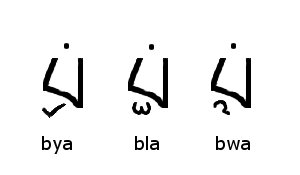The script of Seuna: Difference between revisions
No edit summary |
|||
| Line 20: | Line 20: | ||
An off-gesture or off-flurish is when an initial consonant is followed by "y","l" or "w" (talking phonetically here). | An off-gesture or off-flurish is when an initial consonant is followed by "y","l" or "w" (talking phonetically here). | ||
Off-gestures only occur word initially and are restricted to certain letters (see XXXX section xxxx). | |||
[[Image:Bitmap_7_Seuna.PNG]] | |||
== On-gestures == | == On-gestures == | ||
Revision as of 04:30, 30 December 2008
Consonants
These are the 17 consonants. The ampersand "@" represents a glottal stop.
These 17 shapes have been more or less copied from Tibetan. This subset of the Tibetan alphabet was chosen as I feel that these symbols are distinct from each other but at the same time similar. They were given completely different phonetic values to what they have in Tibetan.
There is no scheme that gives these symbols common elements corresponding to common articulation methods. However it can be noted that "b", "p" and "m" have a common element. As do "h" and "@". Also "g" and "y" are quite similar and in language g => y is quite a common sound change.
There is also no correspondence between how a sound "feels" and how it is written. If that were the case there would be no angle in the "s" and nasal sounds and "k", "p" and "t" would be extremely angular.
Vowels
The vowel marks are given below. They are written above the consonant that they follow. According to approved articulation, no syllable should begin with a vowel ; there should be a glottal-stop then a vowel. However to drop the glottal-stop seems to be quite common, in which case the first figure given in the consonants list is merely a place-holder to mount the vowel on.
Off-gestures
An off-gesture or off-flurish is when an initial consonant is followed by "y","l" or "w" (talking phonetically here). Off-gestures only occur word initially and are restricted to certain letters (see XXXX section xxxx).
On-gestures
An on-gesture or on-flurish is when a middle consonant is followed by a lateral a nasal or a sibilant.
Unadorned words
In the Seuna writing system, some 2,000 of the most common words always occur in their unadorned form. This is the word shorn of vowel marks. For example "to walk" = dono. This happens to be the word choosen from all the two syllable words with initial event D and secondary event N.
Vowels and initial-consonant-tail-gestures and secondary-consonant-head-gestures will be represented as lower case letters.
kloga = shoe => K˪oGa
tolnu = to grind => TolNu
dono = to walk => DN and not (DoNo)
Minor heading
Index
- Introduction to Seuna
- Seuna : Chapter 1
- Seuna word shape
- The script of Seuna
- Seuna sentence structure
- Seuna pronouns
- Seuna nouns
- Seuna verbs (1)
- Seuna adjectives
- Seuna demonstratives
- Seuna verbs (2)
- Asking a question in Seuna
- Seuna relative clauses
- Seuna verbs (3)
- Methods for deriving words in Seuna
- List of all Seuna derivational affixes
- Numbers in Seuna
- Naming people in Seuna
- The Seuna calendar
- Seuna units


